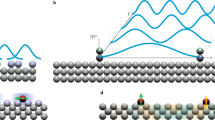Abstract
In a very short time the scanning tunnelling microscope has become an important tool in surface science, and physics in general1–3. Its primary use has been to obtain atomic-resolution images of surfaces, but recently, efforts have been made to use it to manipulate materials as well as image them4–10. One may now reasonably ask if it is possible to move and alter matter predictably on an atomic scale. Here we report the accomplishment of the smallest yet, purposeful, spatially localized changes in matter, effected on a graphite surface. We believe that the changes result from the pinning of individual organic molecules to the graphite. The reverse manipulation, the removal of pinned molecules, has also been demonstrated. Finally, we have evidence that we can remove a portion of a pinned molecule, effectively performing transformations on single molecules using the tunnelling microscope.
This is a preview of subscription content, access via your institution
Access options
Subscribe to this journal
Receive 51 print issues and online access
$199.00 per year
only $3.90 per issue
Buy this article
- Purchase on Springer Link
- Instant access to full article PDF
Prices may be subject to local taxes which are calculated during checkout
Similar content being viewed by others
References
Binnig, G. & Rohrer, H. Helv. phys. Acta 55, 726–735 (1982).
Binnig, G., Rohrer, H., Gerber, C. & Weibel, E. Phys. Rev. Lett. 50, 120–123 (1983).
IBM JI Res. Dev. 30, 353–572 (1986).
Becker, R. S., Golovchenko, J. A. & Swartzentruber, B. S. Nature 325, 419–421 (1987).
Silver, R. M., Ehrichs, E. E. & de Lozanne, A. L. Appl. Phys. Lett. 51, 247–249 (1987).
McCord, M. A. & Pease, R. F. W. J. Vac. Sci. Technol. B4, 86–88 (1986).
Ringger, M., Hedber, H. R., Schlogl, R., Oelhafen, P. & Guntherodt, H. J. Appl. Phys. Lett. 46, 832–834 (1985).
Abraham, D. W., Mamin, H. J., Ganz, E. & Clarke, J. IBM JI Res. Dev. 30, 492–499 (1986).
Stauter, U. et al. Appl. Phys. Lett. 51, 244–246 (1987).
Schneir, J. et al. J. appl. Phys. (in the press).
Bryant, A., Smith, D. P. E. & Quate, C. F. Appl. Phys. Lett. 48, 832–834 (1986).
Park, S. I. & Quate, C. F. Appl. Phys. Lett. 48, 112–114 (1986).
Batra, I. P. et al. Surf. Sci. 181, 126–138 (1986).
Bryant, A., Smith, D. P. E., Binning, G. Harrison, W. A. & Quate, C. F. Appl. Phys. Lett. 49, 936–938 (1986).
Reihl, B., Gimzewski, J. K., Nicholls, J. M. & Tosatti, E. Phys. Rev. B33, 5770–5773 (1986).
Mizes, H. A., Sang-il, Park & Harrison, W. A. Phys. Rev. B36, 4491–4494 (1987).
Author information
Authors and Affiliations
Rights and permissions
About this article
Cite this article
Foster, J., Frommer, J. & Arnett, P. Molecular manipulation using a tunnelling microscope. Nature 331, 324–326 (1988). https://doi.org/10.1038/331324a0
Received:
Accepted:
Issue Date:
DOI: https://doi.org/10.1038/331324a0
This article is cited by
-
35 atoms that changed the nanoworld
Nature Nanotechnology (2010)
-
Intercalation and deintercalation of transition metal dichalcogenides: Nanostructuring of intercalated phases by scanning probe microscopy
Ionics (2000)
Comments
By submitting a comment you agree to abide by our Terms and Community Guidelines. If you find something abusive or that does not comply with our terms or guidelines please flag it as inappropriate.



